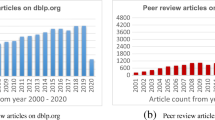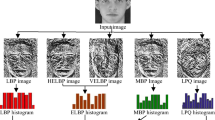Abstract
The sparse representation based classification methods has achieved significant performance in recent years. To fully exploit both the holistic and locality information of face samples, a series of sparse representation based methods in spatial pyramid structure have been proposed. However, there are still some limitations for these sparse representation methods in spatial pyramid structure. Firstly, all the spatial patches in these methods are directly aggregated with same weights, ignoring the differences of patches’ reliability. Secondly, all these methods are not quite robust to poses, expression and misalignment variations, especially in under-sampled cases. In this paper, a novel method named robust sparse representation based classification in an adaptive weighted spatial pyramid structure (RSRC-ASP) is proposed. RSRC-ASP builds a spatial pyramid structure for sparse representation based classification with a self-adaptive weighting strategy for residuals’ aggregation. In addition, three strategies, local-neighbourhood representation, local intra-class Bayesian residual criterion, and local auxiliary dictionary, are exploited to enhance the robustness of RSRC-ASP. Experiments on various data sets show that RSRC-ASP outperforms the classical sparse representation based classification methods especially for under-sampled face recognition problems.
Similar content being viewed by others
References
Basri R, Jacobs D. Lambertian reflectance and linear subspaces. Pattern Anal Mach Intell, 2003, 25: 218–233
Qiao L, Chen S, Tan X. Sparsity preserving discriminant analysis for single training image face recognition. Pattern Recogn Lett, 2010, 31: 422–429
Candès E, Romberg J, Tao T. Stable signal recovery from incomplete and inaccurate measurements. Commun Pure Appl Math, 2006, 59: 1207–1223
Donoho D. For most large underdetermined systems of linear equations the minimal 1-norm solution is also the sparsest solution. Commun Pure Appl Math, 2006, 59: 797–829
Wright J, Yang A, Ganesh A, et al. Robust face recognition via sparse representation. IEEE Trans Pattern Anal Mach Intell, 2009, 31: 210–227
Zhang L, Yang M, Feng X. Sparse representation or collaborative representation: which helps face recognition? In: Proceedings of International Conference on Computer Vision (ICCV), Barcelona, 2011. 471–478
Yang M, Zhang L. Gabor feature based sparse representation for face recognition with gabor occlusion dictionary. In: Proceedings of the 11th European Conference on Computer Vision (ECCV), Heraklion, 2010. 448–461
Ma L, Wang C, Xiao B, et al. Sparse representation for face recognition based on discriminative low-rank dictionary learning. In: Proceedings of the IEEE Conference on Computer Vision and Pattern Recognition (CVPR), Providence, 2012. 2586–2593
Deng W, Hu J, Guo J. Extended src: undersampled face recognition via intraclass variant dictionary. Pattern Anal Mach Intell, 2012, 34: 1864–1870
Deng W, Hu J, Guo J. In defense of sparsity based face recognition. In: Proceedings of the IEEE Conference on Computer Vision and Pattern Recognition (CVPR), Portland, 2013. 399–406
Wei C, Wang Y. Learning auxiliary dictionaries for undersampled face recognition. In: Proceedings of International Conference on Multimedia and Expo (ICME), San Jose, 2013. 1–6
Yang M, Zhang L, Feng X, et al. Fisher discrimination dictionary learning for sparse representation. In: Proceedings of IEEE International Conference on Computer Vision (ICCV), Barcelona, 2011. 543–550
Feng J, Ma X, Zhuang W. Collaborative representation bayesian face recogntion. Sci China Inf Sci, 2017, 60: 048101
Beck A, Teboulle M. A fast iterative shrinkage-thresholding algorithm for linear inverse problems. Siam J Imag Sci, 2009, 2: 183–202
Yang J, Zhang Y. Alternating direction algorithms for l1-problems in compressive sensing. Siam J Sci Comput, 2009, 33: 250–278
Li J, Lu C. A new decision rule for sparse representation based classification for face recognition. Neurocomputing, 2013, 116: 265–271
Liu B, Shen B, Gui L, et al. Face recognition using class specific dictionary learning for sparse representation and collaborative representation. Neurocomputing, 2016, 204: 198–210
Lu Z, Zhang L. Face recognition algorithm based on discriminative dictionary learning and sparse representation. Neurocomputing, 2016, 174: 749–755
Ouyang Y, Sang N, Huang R. Accurate and robust facial expressions recognition by fusing multiple sparse representation based classifiers. Neurocomputing, 2015, 149: 71–78
Grauman K, Darrell T. The pyramid match kernel: discriminative classification with sets of image features. In: Proceedings of International Conference on Computer Vision (ICCV), Beijing, 2005. 1458–1465
Lazebnik S, Schmid C, Ponce J. Beyond bags of features: spatial pyramid matching for recognizing natural scene categories. In: Proceedings of the 2006 IEEE Computer Society Conference on Computer Vision and Pattern Recognition (CVPR), New York, 2006. 2169–2178
Yang J, Yu K, Gong Y, et al. Linear spatial pyramid matching using sparse coding for image classification. In: Prcoeedings of IEEE Conference on Computer Vision and Pattern Recognition (CVPR), Miami, 2009. 1794–1801
Yu K, Lv F, Huang T, et al. Locality-constrained linear coding for image classification. In: Proceedings of IEEE Conference on Computer Vision and Pattern Recognition (CVPR), San Francisco, 2010. 3360–3367
Shen F, Tang Z, Xu J. Locality constrained representation based classification with spatial pyramid patches. Neurocomputing, 2013, 101: 104–115
Yang M, Zhang L, Shiu S C, et al. Robust kernel representation with statistical local features for face recognition. IEEE Trans Neural Netw Learn Syst, 2013, 24: 900–912
Zhu P, Yang M, Zhang L, et al. Local generic representation for face recognition with single sample per person. In: Proceedings of Asian Conference on Computer Vision (ACCV), Singapore, 2014. 34–50
Wang J, Yang J, Yu K, et al. Robust local representation for face recognition with single sample per person. In: Proceedings of the 3rd IAPR Asian Conference on Pattern Recognition (ACPR), Kuala Lumpur, 2015
Boureau Y, Bach F, Lecun Y, et al. Learning mid-level features for recognition. In: Proceedings of IEEE Conference on Computer Vision and Pattern Recognition, San Francisco, 2010. 2559–2566
Zhou X, Yu K, Zhang T, et al. Image classification using super-vector coding of local image descriptors. In: Proceedings of the 11th European Conference on Computer vision (ECCV): Part V, Heraklion, 2010. 141–154
Moghaddam B, Nastar C, Pentland A. Bayesian face recognition using deformable intensity surfaces. In: Proceedings of the IEEE Conference on Computer Vision and Pattern Recognition (CVPR), San Francisco, 1996. 638–645
Moghaddam B, Jebara T, Pentland A. Bayesian face recognition. Pattern Recogn, 2000, 33: 1771–1782
Georghiades A, Belhumeur P, Kriegman D. From few to many: illumination cone models for face recognition under variable lighting and pose. Pattern Anal Mach Intell, 2001, 23: 643–660
Martinez A. The AR Face Database. Cvc Technical Report, 24. 1998
Gross R, Matthews I, Cohn J, et al. Multi-PIE. Image Vision Comput, 2010, 28: 807–813
Wolf L, Hassner T, Taigman Y. Similarity scores based on background samples. In: Proceedings of the 9th Asian Conference on Computer Vision (ACCV), Xi’an, 2009. 88–97
Yang M, Dai D, Shen L, et al. Latent dictionary learning for sparse representation based classification. In: Proceedings of IEEE Conference on Computer Vision and Pattern Recognition (CVPR), Columbus, 2014. 4138–4145
Acknowledgments
This work was supported by National Natural Science Foundation of China (Grant Nos. 61333015, 61302127, 11326198), China Postdoctoral Science Foundation (Grant No. 2015M570228), Opening Foundation of Tianjin Key Laboratory of Intelligence Computing and Novel Software Technology, Tianjin Key Projects in the National Science and Technology Pillar Program (Grant No. 14ZCZDGX00033), and International Fostering Plan of Selected Excellent Postdoctors Subsidized by Tianjin City (2015). Thanks for the academic visiting support of the China Scholarship Council.
Author information
Authors and Affiliations
Corresponding author
Rights and permissions
About this article
Cite this article
Ma, X., Zhang, F., Li, Y. et al. Robust sparse representation based face recognition in an adaptive weighted spatial pyramid structure. Sci. China Inf. Sci. 61, 012101 (2018). https://doi.org/10.1007/s11432-016-9009-6
Received:
Revised:
Accepted:
Published:
DOI: https://doi.org/10.1007/s11432-016-9009-6




